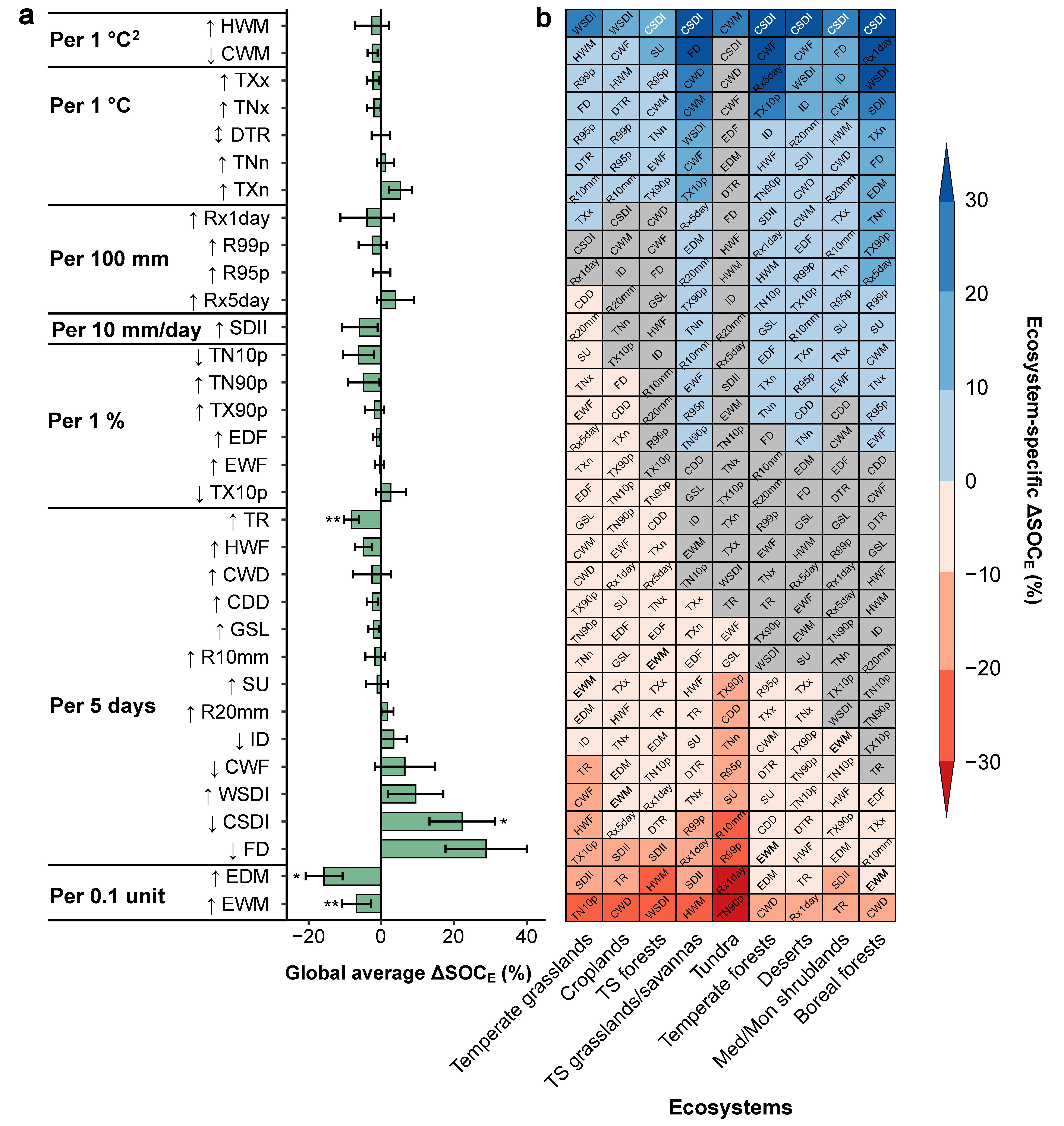Climate extremes exacerbate soil carbon loss under warming
Published in Earth & Environment

Our planet is experiencing more frequent and intense climate extremes (e.g., droughts, heatwaves, and flooding) under a warming climate. Ecosystems are especially sensitive to such shifts of climate extremes. Satellite-based observations indicate that even a single climate extreme event (e.g., droughts) can substantially damage ecosystem production at the regional scale [1, 2]. The legacy effect of this damage may last for years up to decades, resulting in either immediate and time-lagged consequences on local community livelihood and biogeochemical cycling processes. To better adapt to climate change, a comprehensive understanding of the effects of various climate extreme types on ecosystem processes is vital.
Soil is the largest terrestrial organic carbon reservoir, and stores as twice as carbon stored in vegetation and atmosphere combined. As such, a small change in the soil organic carbon (SOC) pool will cause a significant impact on atmospheric CO2 concentration and vegetation productivity (via CO2 fertilization effect), thereby causing significant feedbacks to climate change. However, it is challenging to accurately predict the fate of soil carbon under future climate conditions, as SOC may need decades or even centuries to settle to the new climate.
In a paper published in Nature Climate Change, co-authors and we developed an innovative approach integrating space-for-time substitution, meta-analysis, and machine learning-based digital soil mapping to estimate SOC changes in response to shifts in climate extremes under global warming. The approach builds upon large global observational datasets of SOC measurements (more than 100k sampling locations) managed by the World Soil Information Service (WoSIS). This data covers the diverse climate, vegetation, landform, and soil types across the globe . Combining with climate variables including the intensity and frequency of climate extremes, the data enables us to use the space-for-time substitution approach to quantify the difference of SOC stocks among climatic conditions with controlled other environmental conditions. Meta-analysis techniques were used to assess the effect sizes of climate extremes and their uncertainties under different background environmental conditions, and machine learning-based models were used to conduct spatially-explicit global digital mapping of SOC changes under 1.5 °C warming plus shifts in climate extremes.
We assessed the effect, respectively, of shifts in 33 climate extremes defined by the Expert Team on Climate Change Detection and Indices (ETCCD) including eight types indicating the frequency and magnitude of heatwaves, cold wave, extreme dry, and extreme wet. The results indicated that averaging across the globe, 22 out of 33 climate extremes exacerbate warming-induced SOC losses. Especially, the number of tropical nights and cold spell duration are the two most important climate extremes, exacerbating and alleviating warming-induced SOC losses, respectively. In addition, we found that compound climate extremes, such as hot-dry extreme events [3], have a more pronounced effect on SOC compared to single climate extremes. For example, hot-dry compound extreme induced additional 10% SOC loss compared to single hot or dry extremes. As the occurrences of compound extremes are likely to increase in the future, it will be a big threat to global SOC pool, challenging the effectiveness of SOC sequestration to mitigate climate change.
The impact of climate extreme shifts on SOC is ecosystem-dependent. SOC in grasslands showed the largest vulnerability to climate extremes, with 22 of 33 climate extremes intensify SOC loss under warming. In boreal forests, 16 out of the 33 climate extremes, on the contrary, alleviate warming-induced SOC losses, 12 have no significant effects, and the remaining five significantly increase warming-induced carbon loss. In general, the impacts of climate extremes are extreme type-dependent. Climate extremes related to heat extremes, such as increasing heatwave magnitude and frequency, daily maximum temperature and the number of tropical nights, intensify SOC losses, while those related to cold extremes, such as less frost days, and shorter cold spell duration, can offset warming-induced SOC loss.
We also mapped the global spatial pattern of the impacts of eight integrated climate extremes on SOC under a warmer climate. There are hotspots where SOC is vulnerable to climate extremes, although global average SOC changes induced by climate extreme shifts are small. These regions mainly locate in Europe, Southeast Asia, North America, and the Amazon. Unfortunately, these regions have also been predicted to experience more frequent and intense climate extremes under future climate conditions [4]. So, soil in these regions may be a main contributor to carbon source for atmosphere CO2 in the future.
The implications of this study are significant. It underscores the importance of considering ecosystem type and region-specific impacts when developing strategies for carbon preservation and sequestration. The findings also emphasize the urgent need for further research into the underlying mechanisms of these diverse responses. In an era of shifting climate patterns, understanding how climate extremes influence soil carbon dynamics is essential for developing effective land management strategies and mitigating the impact of climate change on our planet's carbon balance.

Follow the Topic
-
Nature Climate Change

A monthly journal dedicated to publishing the most significant and cutting-edge research on the nature, underlying causes or impacts of global climate change and its implications for the economy, policy and the world at large.



Please sign in or register for FREE
If you are a registered user on Research Communities by Springer Nature, please sign in